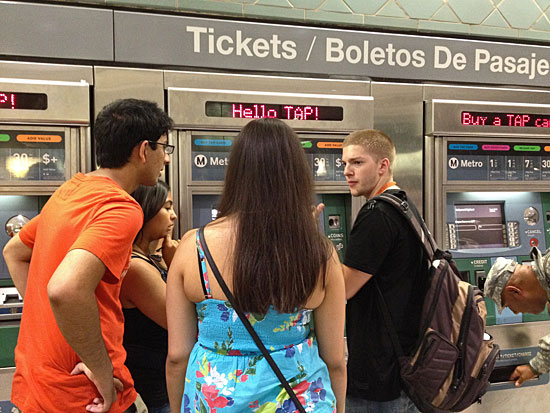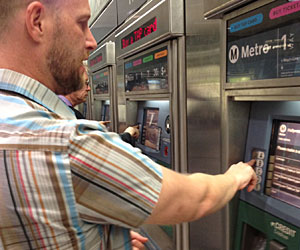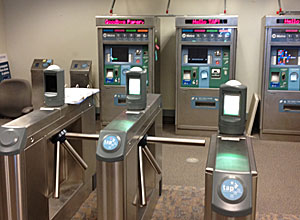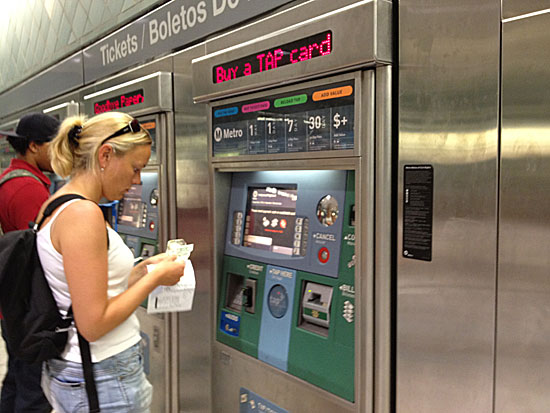What’s on TAP? For some, confusion
September 13, 2012
All Brandon Crosby wanted was to hop aboard the Red Line subway and travel one stop—from Hollywood/Highland to Hollywood/Vine—to get to the box office at the Pantages Theatre.
But for Crosby, the journey of a single stop began with a thousand questions.
Standing at a bank of Metro ticket vending machines Tuesday afternoon, Crosby was flummoxed and increasingly exasperated as he tried to figure out how to buy a ticket to get him to the theater and back. The machine was offering him no choice but to buy something he didn’t see why he needed—a $1 plastic TAP card—along with his regular fare. And where was the round trip option? Then, when he pushed the “help” button, he got even more confused when the machine told him that his preferred purchase—a paper ticket for one-time use—was available, when in fact it was not.
“It makes no sense to me,” said Crosby, an L.A. resident who usually drives but wanted to give the subway a try for what he thought would be a quick jaunt. “I hate it.”
He’s not alone. While thousands of regular and occasional Metro train riders seem to be adapting well to the agency’s new, mandatory TAP card system that’s rolling out this summer, first-timers, tourists and people who haven’t ridden Metro trains lately are encountering trouble on the tracks. Some seniors are complaining, too, about having a hard time finding the reduced-fare options on the ticket machines’ new menu of purchase alternatives.
David Sutton, Metro’s director of TAP operations, is sympathetic to their concerns. But given the magnitude and complexity of the changeover to the loadable fare cards, he believes the transition is going well overall.
Already, some 400,000 to 500,000 TAP cards are in active use. Nine of the region’s municipal bus lines, along with the city of Los Angeles’ DASH and Commuter Express buses, are now part of the program (although cash is still being accepted on buses system-wide.)
The complete range of Metro passes has now been integrated into the TAP program, and efforts are underway to do the same with Metrolink and EZ Transit passes as well.
Metro’s changeover to TAP has been in the planning and testing phases for years. It’s a necessary precursor to another longstanding goal: locking the turnstiles at Metro stations so fare-beaters finally will be forced to pay their fair share.
That objective makes it all worthwhile, said George Ortiz, a regular rider who’s studying to be a sound engineer in Hollywood.
“It’s actually pretty good that they did it,” Ortiz said. “I would see people get on the Metro without paying.”
And once riders figure out how to get that initial TAP card—or, on a more basic level, understand what a TAP card is and why they need to buy one—many seem at peace with the process.
“It wasn’t bad except for the very first part I was confused, because I didn’t know what a TAP card was,” said Randy Riggs, visiting from Las Vegas. “The rest of it was pretty easy.”
“It’s actually not bad. It was just confusing at first,” added Prentice Deadrick Jr., a student who commutes regularly from the San Gabriel Valley to school in Hollywood. It doesn’t help, he said, that the ticket machine changeover is being staggered—so that riders can still buy paper tickets at one station but can only purchase TAP cards at others. (The timetable for converting the remaining machines is here, including Orange Line stations from September 6-12 and Union Station from September 17-20.)
“They should have done it all at one time, instead of some spots have paper, some spots have TAP,” Deadrick said.
Sue Bromley, a tourist from Australia who was heading to the Dodgers game with her husband, suggested that it would help to have a ticket agent on hand to explain things.
Back home in Sydney, she said, public transit riders buy paper tickets from machines, “but we still have people at the ticket office as well.”
As each station’s ticket machines are converted, Metro assigns field representatives to assist travelers for the first couple of days. But then they move on, leaving confounded would-be ticket-buyers on their own.
At the Hollywood & Highland station Tuesday afternoon, first-time users looked in vain for somebody—anybody—to show them the ropes.
Some gave up. Others got assistance from passing commuters, a writer for Supervisor Yaroslavsky’s website, even a panhandler who was working the crowd for small change.
(For the record, their questions went well beyond the operation of the ticket machines. They also wanted to know what time the trains stop running, whether day passes were good for a calendar day or for 24 hours, and the best place to get a good view of the Hollywood sign.)
Even with the impromptu help, some walked away shaking their heads. “It’s too complicated to see how it works,” said Sabine Pflipsen, who was visiting from Germany. “If you just want to have a ticket, you have to buy a plastic card. Why can’t I take a ticket for $1.50 and it’s done? I need to get this plastic thing? And it’s not explained in my traveling booklets.”
Gail Harvey, Metro’s director of customer relations, said she rarely hears from tourists like Pflipsen but is getting an earful from seniors these days.
Her staff receives some 20 complaints a day about the TAP changeover, virtually all of them from seniors having difficulties purchasing their customary reduced fares on the reformatted machines.
Typical comments range from “I missed it” to “Why don’t we have paper anymore?”
Sutton, director of TAP operations for the past year, feels their pain.
“It’s daunting when you first face one of our machines. People are used to more intuitive technology these days,” he said, such as touch screen machines being tested in other markets.
For now, he said, Metro is working as fast as it can to finish updating ticket machines at all the stations by September 20 and fixing glitches like the contradictory information that’s still on the machines’ “help” screens.
There’s no money in the budget to place workers permanently at stations to answer travelers’ questions, he said, but new signs are being printed and affixed to the machines.
Eventually, he predicted, buying and using TAP cards will become second nature to the traveling public.
“Change is hard for everybody and a lot of folks are used to buying paper tickets,” he said. “When ATMs came out, my dad said he would never use one. Eventually, he converted.”
Posted 9/6/12
















 405 bridge work causes a stink
405 bridge work causes a stink

